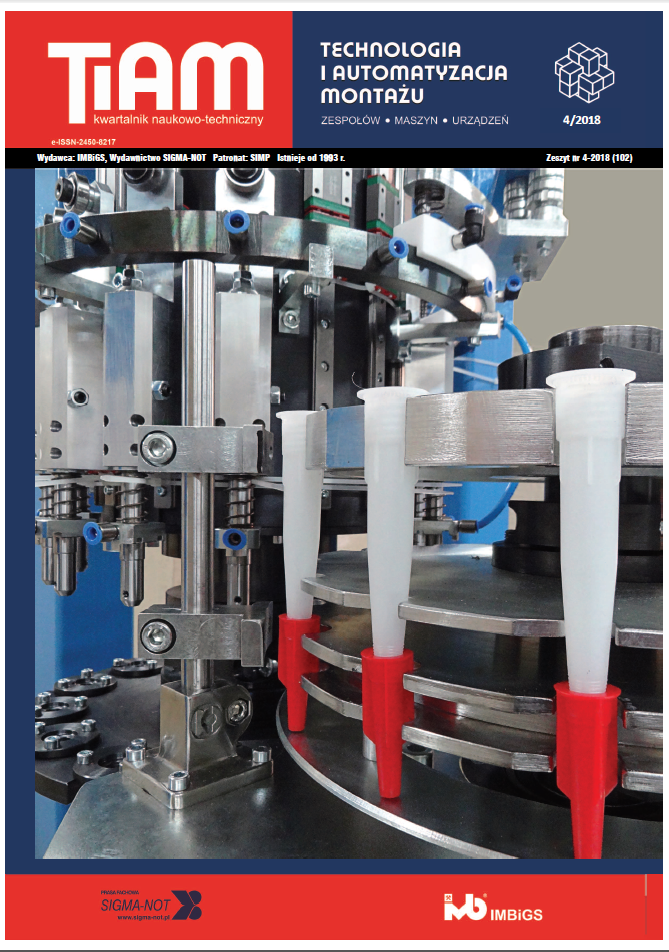Abstract
The paper presents the results of experimental research on longitudinal ribbing in thin sheets, made as stiffening ribs. The issue concerns ribbing formed in 2024-T3 aluminum alloy plates, 0.4 mm thick. The embossing was made using a relatively new technology, the so-called incremental sheet forming, which is a point of deformation of the material through the tool in the form of a plunger, gradually penetrated into the material in accordance with a defined path that determines the shape of the final embossing. Forming was carried out using a three-axis numerical milling machine using a 6 mm diameter tool with a head radius of R3. Embossments 120 mm long and 20 mm wide were formed. As part of the research, different depths of embossing were considered, grading them every 1 mm in the range from 1 to 5 mm. The highest value of the depth with the given value was assumed, because above the 5.5 mm depth the shaped sheet was cracking, so the value of 5 mm was considered the maximum for which the analyzes were carried out.
For the described embossments static buckling tests were made, on the basis of which it was found that the embossing depth of 4 mm is a critical value, because the buckling force for extrusions in the range from 1 to 4 mm increases in direct proportion to the depth of the ribbing, while at a depth of 5 mm force this falls.
This is an Open Access article distributed under the terms of the Creative Commons Attribution License CC BY 4.0 (https://creativecommons.org/licenses/by/4.0/)
References
Bagudanch I., et. al. 2017. "Revisiting formability and failure of polymeric sheets deformed by Single Po¬int Incremental Forming". Polymer Degradation and Stability 144: 366-377.
Centenoa G. et. al. 2017. "Recent approaches for the manufacturing of polymeric cranial prostheses by Incremental Sheet Forming". Procedia Engineering (183): 180-187.
Devarajan N. et. al. 2014. "Complex incremental sheet forming using back die support on aluminium 2024, 5083 and 7075 alloys". Procedia Enineering (81): 2298-2304.
Emmens W.C. 2010. "The technology of Incremental Sheet Forming - A brief review of the history". Journal of Materials Processing Technology (210): 981-997.
Jackson K.P., Allwood J.M., Landert M. 2008. "Incre-mental Forming of Sandwich Panels". Journal of Ma-terials Processing Technology (204/1-3): 290-303.
Jadhav S. et. al. 2003. "Process optimization and control for incremental forming sheet metal forming". Proceedings of the International Deep Drawing Research Group Conference, IDDRG, Bled, Slove-nia,165-171.
Jeswiet J. 2005. "Asymmetric single point incremental forming of sheet metal". Annals of CIRP Vol. 54 (2): 623-650.
Le V.S., Ghiotti A., Lucchetta G. 2008. "Preliminary Studies on Single Point Incremental Forming for Thermoplastic Materials". International Journal of Material Forming (1): 1179-1182.
Marques TA, Silva M.B., Martins P.A.F. 2012. "On the potential of single point incremental forming of sheet polymer parts". The International Journal of Advanced Manufacturing Technology, vol. 60, issue 1-4: 75-86.
Naranjo J. et. al. 2017. "Influence of temperature on alloy Ti6AI4V formability during the warm SPIF process". Procedia Engineering (207): 866--871.
Raju C., Haloi N., Narayanan C.S. 2017. "Strain distribution and failure mode in single point incremental forming (SPIF) of multiple commercially pure aluminum sheets". Journal of Manufacturing Processes (30): 328-335.
Sa de Farias J. 2014. ''Towards smart manufacturing techniques using incremental sheet forming". Smart manufacturing innovation and transformation: Inter-connection and Intelligence, IGI Global.
Salem E. 2016. "Investigation of thickness variation in single point incremental forming". Procedia Manufacturing Vol. 5: 828--837.
Shim M.S., Park J.J. 2001. "The formability of aluminum sheet in incremental forming". Journal of Material Processing Technology Vol. 113, Issue 1-3: 654--658.


